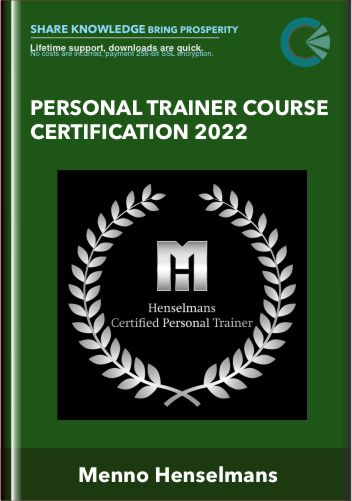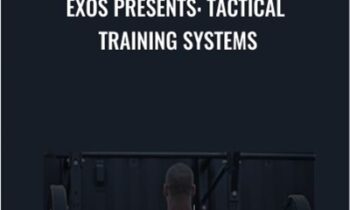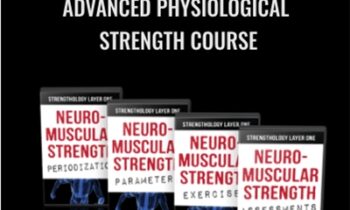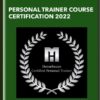$1,899.00 Original price was: $1,899.00.$375.00Current price is: $375.00.
[ Pre-Order ] Personal Trainer Course Certification 2022 – Menno Henselmans… Thanks to our online format, we can keep the course updated weekly with the latest scientific findings, and even some yet unpublished data from our research team. You won’t be learning from a textbook written 5 years ago.
[ SALE PAGE]
 Purchase this course you will earn 375 Points worth of $37.50
Purchase this course you will earn 375 Points worth of $37.50Elevate your skills with the Personal Trainer Course Certification 2022 – Menno Henselmans course, available for just $1,899.00 Original price was: $1,899.00.$375.00Current price is: $375.00. on Utralist.com! Browse our curated selection of over 60,000 downloadable digital courses across diverse Health and Medical. Benefit from expert-led, self-paced instruction and save over 80%. Start learning smarter today!
Personal Trainer Course Certification 2022 – Menno Henselmans
 The Henselmans PT Course Certification
The Henselmans PT Course Certification
Comprehensive, science-based fitness education taught by Menno Henselmans
Science-based and up-to-date
Are you looking for robust, evidence-based information?
The Henselmans PT Course will teach you how to become an evidence-based fitness professional. All of the materials in the course are supported with hyperlinks to the scientific articles, just like in the articles on this site but better.
Thanks to our online format, we can keep the course updated weekly with the latest scientific findings, and even some yet unpublished data from our research team. You won’t be learning from a textbook written 5 years ago.
Learn from Menno Henselmans directly
You will learn Menno’s full coaching approach
The course costs $100 less than Menno’s hourly consultation rate (299 USD) and Menno will answer all of your questions in the Facebook discussion group and live Q&A sessions.
Menno will host multiple live video Q&A sessions. You will also have unlimited access to Menno’s inbox for private questions.
A complete and extremely comprehensive course
Do you find other courses are lacking, dated or missing depth?
We cover more than most courses. This course will take you from the basics to expert level knowledge.
You will learn everything you need to help others lose fat, build muscle and live a healthier lifestyle. We’ll also extensively go into food choices for optimal health, diet adherence and many more niche topics: contest prep, tanning, sleep optimization, stress management, getting rid of acne, pregnancy and much more.
Looking to advance or kick-start your career as a Personal Trainer?
You will learn how to apply the science for maximum real-life results in your clients. With our PT toolkits, ready-to-send client guides and case studies, you’ll be ready to help any client achieve their goals.
Pregnant or elderly clients, powerlifters, physique competitors, we cover it all.
We also teach you how to do your own research and set up your business with data-driven marketing techniques.
Many of our students have done multiple courses and say it’s the most valuable investment in their career as a personal trainer.
Menno Henselmans
About the founder and course host
-
BSc magna cum laude, MSc with distinction
-
MPA Award winning model & WBFF Fitness Model Competitor
-
International public speaker for i.a. BodyPower, the Norwegian Academy for Personal Training (AFPT) and the Oxford and Cambridge Alumni AssociationReview author in Sports Medicine, the highest impact factor journal in exercise science & peer-reviewer for the Journal of Human Kinetics
How does the course work?
Every week we will post one or several modules of the course in the course Facebook group. In the comments below this post we will discuss that module during the week.
To roughly summarize the course, the first part of the course deals with nutrition, the second part with exercise science and then several miscellaneous topics are discussed.
The course is fully online, flexible and part-time, so you can follow it alongside your work or studies.
Download the PDF nowto see an overview of all course contents and learn more about how the course works.
Table of contents
Looking to advance and broaden your knowledge?
We cover more than most courses. In 10 months we cover everything from A to Z, in great detail.
To roughly summarize the course, the first part of the course deals with nutrition, the second part with exercise science and then several miscellaneous topics are discussed.
Week 1: How to study and do your own research
How to study and do your own research
- How to improve your reading comprehension and retention
- How to find and read scientific papers
- Understanding statistics
- Improving your logical reasoning skills
Biochemistry 101
- How the body produces energy from proteins, carbohydrates and fats
Week 2 & 3: Human Metabolism and Optimizing energy intake
Human metabolism
- What is energy? Thermodynamics and energy balance
- Components of energy expenditure, refeeds, set-point theory, metabolic damage, adaptive thermogenesis, reverse dieting and the yo-yo effect
Optimizing energy intake
- Cutting, bulking and body recomposition
- How to optimize nutrient partitioning
- How to estimate body fat percentage
- Macro tracking: common pitfalls
- How to measure progression and body composition
Week 4 & 5: Protein requirements and protein timing
Protein requirements
- Protein quality
- Vegetarians & vegans
- Gender, PEDs, training volume
- Surplus vs. deficit
Protein timing
- Protein absorption limits
- The anabolic window, fasted training & workout nutrition
- Protein synching
- Meal frequency
Week 6: Carbohydrates
Carbohydrates
- Types: simple vs. complex, GI, GL, II, fructose
- Requirements per type of exercise
- Carbohydrate timing
- Effects on muscle growth
- Dietary fiber
- Carbohydrate tolerance
Week 7: Dietary fat
Live video Q&A on the macronutrients
Dietary fat
- Types: lipids, triglycerides, fatty acids
- Health effects and functions of the different fatty acids
- Cholesterol metabolism, health effects and optimal dietary intake
- Brown fat
- Effects on hormone production
- Optimal intake for muscle growth
Week 8: Ketogenic dieting
Ketogenic dieting
- Ketosis levels, starvation mode and net carbohydrate intakes
- Keto-adaptation and the keto flu
- Effects on health, metabolism, appetite, performance and protein balance
- Cyclical and targeted ketogenic dieting
- Measuring ketosis
- MCTs and exogenous ketones
- Who is it for? Indications and contraindications
Week 9: Fasting and circadian rhythm effects
Fasting and circadian rhythm effects
- Intermittent fasting & alternate day fasting
- Protein sparing modified fasting (PSMF)
- Circadian rhythm effects: timing considerations for the macronutrients
- Carb backloading
- Interaction effects between carbs and fats
Week 10: Lifestyle factors
Lifestyle factors
- Circadian rhythm control
- How to optimize sleep quality
- How to manage stress
- How to effortlessly increase your activity level
Week 11: Beyond macros: micronutrition
Beyond macros: micronutrition
- Likely deficiencies
- Bloodwork
- Multivitamins: problems and benefits
- The functions of each micronutrient related to fat loss, muscle growth and performance
- How to fill in your micros
Week 12 & 13: Health science and food choices
Health science and food choices
- What makes a diet healthy?
- Effects of food processing: heating, freezing, blending
- Organic, wild and grass-fed
- Low calorie sweeteners, sugar and dietary fiber
- Food choices for health and anabolism: Meat, fish, poultry, dairy, eggs, grains, wheat, gluten, soy, coffee, fruits, vegetables, chocolate, coconut, nuts and alcohol
- Detox diets
- FODMAPs and digestive health
- How to recover from illness
Week 14: Ad libitum dieting: how to lose fat and gain muscle without tracking your macros
Ad libitum dieting: how to lose fat and gain muscle without tracking your macros
- Hunger management strategies
- Physiological vs. psychological regulation of hunger: eating speed, social effects, decision fatigue, sensory-specificity, portion size, biorhythm effects, exercise, sleep, body composition, palatability, meal frequency, sweeteners
Week 15: Contest prep & peak week
Contest prep and the peak week
- Physique sports divisions
- Carbloading
- Electrolyte manipulation
- Diuretics and water cutting
- ‘Shitloading’
- Posing
Week 16: Beauty
Beauty (optional)
- Acne
- Tanning
- Cellulite
- Hair loss
- Dandruff
Week 17: Supplements
Supplements: a complete guide to every supplement worth knowing
Week 18: Hormones and performance enhancing drugs
Hormones and performance enhancing drugs
- Gender-specific regulation of sex hormones
- Interpreting bloodwork
- AAS: risk-reward and how to manage the side-effects
Week 19: Nutrition case studies
Nutrition case studies
Week 20: Muscle anatomy & understanding muscle growth and strength
Muscle anatomy and contraction
Understanding muscle growth & strength
- Mechanisms of muscle growth
- Systemic and local growth regulation: structural balance theory
- Strength vs. size & functional training
Week 21: Cardio for fat loss
Cardio for fat loss
- The fat burning zone
- Fasted cardio
- Estimating energy expenditure per activity
- NEAT compensation
- EPOC
- How to mitigate the interference effect
- HIIT vs. LISS
Week 22: Program design fundamentals
Program design fundamentals
Training intensity
- Effects on fatigue, connective tissue and the nervous system
- Strength vs. size
- The muscle-specific hypertrophy method
Training volume
- How to estimate recovery capacity
- Optimizing and individualizing training volume
Training frequency
- Interaction with volume
- Effects on recovery capacity
- How often should you train each muscle and exercise?
Week 23: Program customization
Program customization
- DNA testing
- Maximum muscular potential and muscular balance
- Work capacity
Week 24: Fitness for woman
Fitness for women
- Sex differences
- Contraception
- Pregnancy
- Menstrual periodization
- Breast implants
Week 25: Program design for the elderly and youth
Program design for the elderly and youth
- Sarcopenia
- Anabolic resistance
Week 26: Muscle functional anatomy: a visual guide
Muscle functional anatomy: a visual guide
- Ab training and spot reduction
- What each muscle does and how to train it
- Ab training and spot reduction
Week 27 & 28: Exercise selection
Exercise selection
- What makes an exercise effective for muscle growth?
- Free weights vs. machines
- Compound vs. isolation exercises
- Accommodating resistance, bands and chains
- Recommended exercises and technique guide
- Counting volume: how much does a certain exercise stimulate a certain muscle?
- Functional differentiation and exercise variety
Week 29: Exercise technique & cueing
Exercise technique & cueing
- What is ‘good technique’?
- The mind-muscle connection
- Strength vs. size
- Repetition tempo
Repetition tempo
Week 30: How to structure your workouts
How to structure your workouts
- Rest intervals
- Active recovery
- Exercise ordering
- Circuit training, supersets, paired sets and more
Week 31: Periodization and progression
Periodization and progression
- Progressive overload and progression models
- What is fatigue?
- Cybernetic/autoregulatory, undulating and linear periodization
- Benchmarking and autoregulation
- Overtraining, overreaching and deloading
Week 32: Training to failure & advanced strength training techniques
Training to failure
Advanced strength training techniques
- Forced reps and drop sets
- RPEs and velocity monitoring
- Reverse pyramiding, cluster sets and myo-reps
- Weighted stretching
- Eccentric overloading
- Post-activation potentiation
- KAATSU/blood flow restriction training
- Breathing techniques
Week 33 & 34: Stretching, postural correction, warming up & injury management
Stretching
Postural correction
Warming up
Injury management
- Pain science
- Ice vs. heat, NSAIDs and RICE
- Rehabilitative tools & equipment
- Foam rolling and massage
- Chiropractic & alternative medicine
- Common injuries of each body part and how to treat them
Week 35: Training gear
Training gear
- Weightlifting belts
- Footwear: what to wear in the gym
- Knee wraps
- Lifting straps
Week 36: Powerlifting
Powerlifting
- Strength vs. size program design
- Peaking & tapering
- Powerlifting technique
- Selecting a competition
Week 37: Training program case studies
Training program case studies
Week 38: The psychology of how to stick to your diet and exercise program
Adherence: the psychology of how to stick to your diet and exercise program
- Psychological effects of nutrition
- Willpower
- The psychology of coaching
- Blood sugar
- Calorie cycling
- Goal setting
- Cheat meals
- Diet breaks
- Social eating events
- How to deal with social pressure
- Food cravings
- Flexible dieting and meal planning
- Assessing client adherence and motivation
Week 39: How to create a successful PT business
Marketing
Advertising
Sales & client communication
Week 40: Exam preparation time – Henselmans PT Course
Buy Now!
Shopping Information
– We provide digital products. Most of products will come to you immediately. But for Pre-Order product, we need 3-7 days to order it for you.
– After you order, the system will create your account and send it to your email. And after your payment, you will receive the download link at the account or directly via your email. If you have any problems with your order, you can contact: .
– If you cannot find the download link, please don’t worry about that. We will update and notify you as soon as possible at 8:00 AM – 8:00 PM (UTC+8).
Let’s get things started! We will go with you!
Cultivate continuous growth with the Personal Trainer Course Certification 2022 – Menno Henselmans course at Utralist.com! Unlock lifetime access to premium digital content, meticulously designed for both career advancement and personal enrichment.
- Lifetime Access: Enjoy limitless access to your purchased courses.
- Exceptional Value: Benefit from savings up to 80% on high-quality courses.
- Secure Transactions: Your payments are always safe and protected.
- Practical Application: Gain real-world skills applicable to your goals.
- Instant Accessibility: Begin your learning journey immediately after buying.
- Device Compatible: Access your courses seamlessly on any device.
Transform your potential with Utralist.com!
You may also like…
Health and Medical
‘Quantum’ Chakra Clearing and Balancing Series – Jonette Crowley
= 52 Points
Personal Development
“Fix My Job” binaural mantra meditation for attracting work you love – Michael Davis Golzmane
= 17 Points
Personal Development
“Is Your Soul Allowing You To Heal?” — All 7 Recordings in the Series (6 Hours of Audio Clearings)
= 83 Points
Related products
Health and Medical
= 53 Points
Health and Medical
= 43 Points
Health and Medical
CDT Dental Coding and Reimbursement Update: Identifying Common Practice Mistakes – Paul Bornstein
= 85 Points
Health and Medical
= 18 Points
Health and Medical
“Male Physique Training Templates” – Renaissance Periodization
= 42 Points
Health and Medical
= 27 Points
Health and Medical
= 43 Points
Health and Medical
= 74 Points




 The Henselmans PT Course Certification
The Henselmans PT Course Certification









